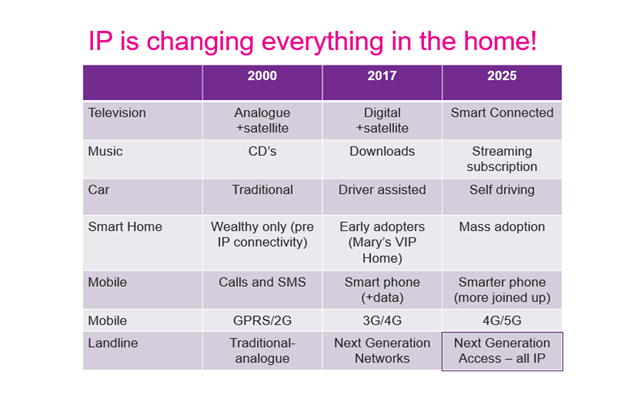Going Digital
Making the case - Benefits of Technology-enabled housing

Below are a set of questions that set out how you might get better connected digitally
How do we gather and publicise the evidence base
There is a lack of places for professionals (commissioners, architects) to keep up to date on CPD in the field of digital technology.
Awareness of what’s available is needed – every successful programme has involved a good educational programme with technology refresher training every 6 months.
Architects and planners won’t be going on courses necessarily. Halls of residence for students will be embedding broadband but may not have same emphasis for older people and extra care.
We need to view “caring technology” as a utility.

Useful information
- Health and housing: building the evidence base (opens new window)
The Housing LIN has written a useful summary for the Kent Surrey Sussex Academic Health Science Network of the evidence base for the connectivity of health and housing. Chapter 8 covers assistive technology and telecare and suggests that there is some evidence that with the right equipment, telecare can enable people to get out and reduce family tensions about care. - Integrated Care and Support at Home (opens new window)
This film, made by the Housing Learning and Improvement Network and Skills for Care, looks at how adult care and housing can integrate their work to improve the quality of life for those with care and support needs. - Future Assisted Living Technology (opens new window)
This briefing by HACT sets out the UK housing sector’s ambition for new technology in retirement living housing for older people and independent living services.
How do we achieve cultural change - Staff knowledge and expertise to support a less risk averse approach to technology?
Traditional social care delivery has a basis in protecting people, and this can often result in a risk averse approach. Including technology in services can help to transform this culture, moving from a focus on problems towards a more inclusive and more enabling approach which supports people to have more control over services, gives them a say in what is an acceptable level of risk and focuses more on what is possible rather than what may not be. This requires awareness, engagement and understanding of the benefits and applications of technology, and a vital tool for achieving this is the use of real life case studies, giving practical examples of the positive impact that technology can have on the lives of service users, to overcome risk aversion.
Regular awareness sessions included as part of staff training can ensure that social care and housing staff who have contact with service users know about the latest technology enabled solutions and are able to discuss them with service users in receipt of respite care, domiciliary care or even faced with a move to residential care. It’s also important to understand the benefits to professionals: enhancing the delivery of homecare services, targeting domiciliary care where it’s needed most, and improving case management.
Examples:
Technology can aid with a number of activities of daily living such as cooking or medication. Options for prompting with medication are useful applications to both the social worker and the service user. For medication, it is essential to get doses and times right. Medication management can be carried out through medication monitoring which provides prompts and sends out calls from the telecare monitoring centre when medication isn’t taken. Reminder functionality, via a lifeline home unit, can be easily set up also; managing the number of visits social workers and/or other care staff need to make and increasing the independence of service users.
Cooking and making meals is another important part of daily living activities. For individuals who live on their own, smoke detectors, temperature extremes sensors and gas alarms can be linked to telecare alarm systems. Intelligent cookers are also available which can minimize risk by detecting that the cooker hob is on but with no pan, so will turn itself off as well as being able to set time periods for cooking. Apps that provide video chat functionality can be used by service users and social workers or care staff to enable individuals to be supported during the cooking process and maintain user safety.
In many ways technology can provide an increased level of risk management, safeguarding people 24 hours a day by ensuring access to help in the event of an emergency. What telecare does is give communities and people more control – this is about increasing choice, with support targeted where and when it is needed the most. This is a complimentary to other services rather than a replacement. Technology is about helping the person maintain independence, choice and self-determination so they can live life to the full, key tenets of promoting wellbeing under the Care Act.
Potentially care provided before was targeted at a specific time period during the day and rest of the day a person may be exposed to any type of risk. Now with digital technology, online services such as skype, messaging, online chat rooms etc increase the opportunity to interact with others who may be many miles away.
Technological solutions are not about replacing human contact or restricting independence. Technology is about helping the person maintain independence, choice and self-determination so they can live life to the full.
Useful information
- How housing associations can prepare for the digital switchover (opens new window)
- Developing local digital leadership skills and capacity (opens new window)
- Connecting people, improving lives. A digital future for TEC? (opens new window)
- Help at Home - Use of assistive technology for older people (opens new window)
What are the issues around ethics and consent?
Are there ethical/safe guarding issues that should be built in? Some standards are light, there is a gap in the IP. Standards are 30 years old. In terms of other types of safe guarding, there are opportunities to use technology and data for other safeguarding, such as ensuring people are getting the support that relatives think they are (eg. Security cameras watching carers). Sensors can highlight if things are not going the way that you want them to. When looking at trends, 24/7 is not an urgent issue.
Data sharing protocols across housing/health/social care need careful consideration.
Useful links
Please email info@housinglin.org.uk if there is a resource that addresses any of the questions on this page.